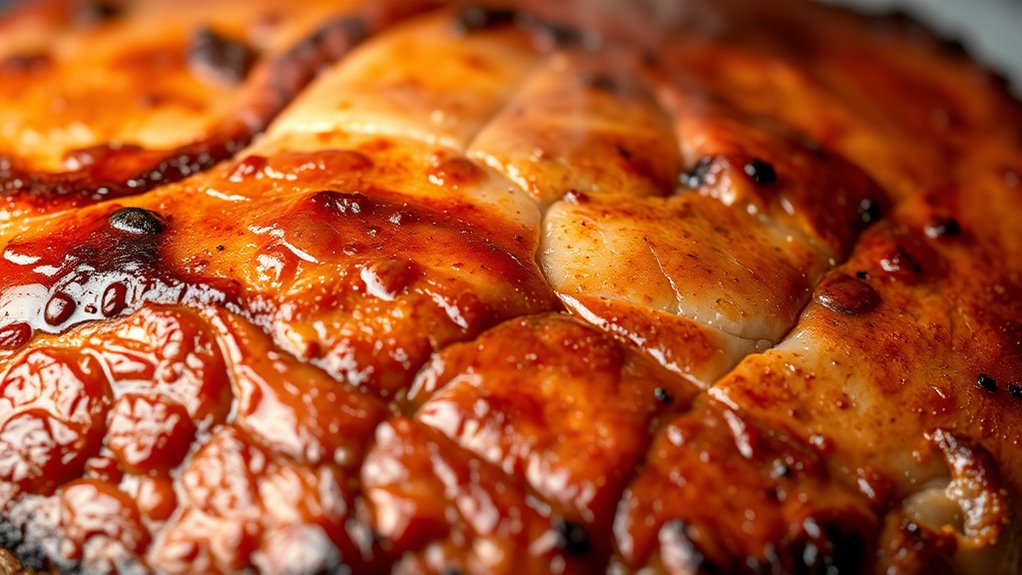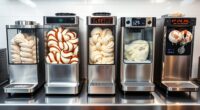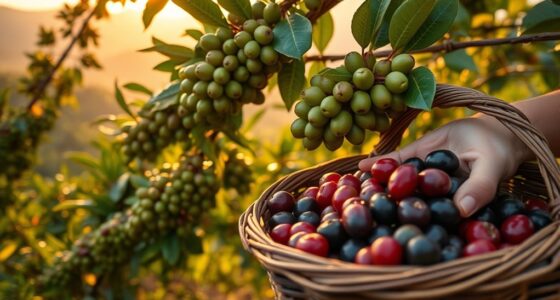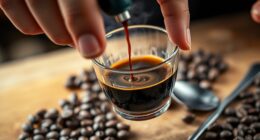The Maillard reaction is a chemical process where amino acids and reducing sugars react under heat, creating browning, complex flavors, and inviting aromas. It directly influences how your roast develops, with factors like temperature, moisture, and bean composition shaping the outcome. Controlling these elements allows you to fine-tune flavor and color, making each roast unique. To discover how to optimize this process for better profiles, keep exploring these essential techniques.
Key Takeaways
- The Maillard reaction occurs when amino acids and reducing sugars interact at specific temperatures, producing browning and complex flavors.
- It significantly influences roast color, aroma, and flavor profiles by creating rich, inviting notes during heating.
- Temperature, moisture, and timing control are crucial to optimize the Maillard reaction without burning the food.
- Promoters like added amino acids or sugars can accelerate Maillard browning and flavor development.
- Managing roasting stages ensures balanced flavor development, highlighting the Maillard reaction’s role in shaping roast profiles.
What Is the Maillard Reaction and How Does It Occur?
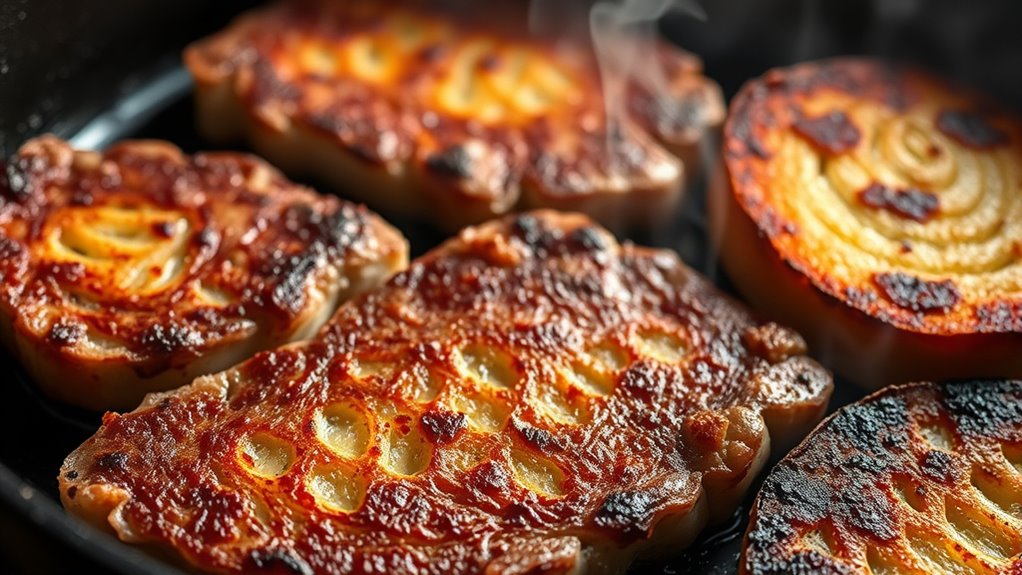
Have you ever wondered what causes that delicious browning and complex flavor in toasted bread or grilled meat? The Maillard reaction is responsible. It occurs when you heat food to specific temperatures, where amino acids and reducing sugars react. Temperature optimization is key—too low, and the reaction slows; too high, and you risk burning the surface. Moisture control also plays an integral role; excess moisture prevents browning by lowering surface temperature, while dry conditions promote better heat transfer. As you heat your food, these factors create the perfect environment for the Maillard reaction to happen, leading to those appealing flavors and golden-brown crusts. Understanding this process helps you master cooking techniques that enhance taste and appearance. Proper temperature control and moisture management are essential for achieving the desired browning and flavor development during cooking.
The Chemistry Behind Browning and Flavor Formation
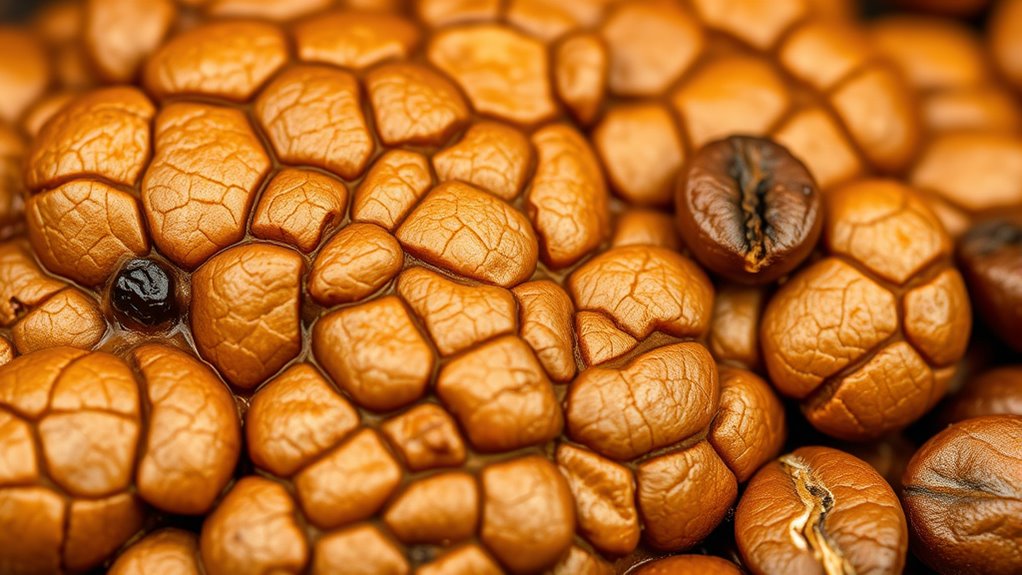
The Maillard Reaction creates the rich browning and complex flavors you notice when cooking. It involves a series of chemical changes between amino acids and sugars that develop these qualities. Understanding this process reveals how heat transforms simple ingredients into savory, appealing dishes. Additionally, the specific flavor profiles produced can be influenced by the types of amino acids and sugars present in the ingredients.
Maillard Reaction Process
When heat is applied to food containing amino acids and sugars, a complex series of chemical reactions begins that leads to browning and the development of rich flavors. The Maillard reaction kicks off as sugars undergo caramelization, contributing to color and sweetness, while enzyme activity influences early stages of browning. As temperatures rise, amino acids react with reducing sugars, forming new compounds that create complex flavors and aromas. Key points include:
- Sugar caramelization enhances browning and sweetness
- Enzyme activity affects initial reaction rates
- The formation of Maillard products leads to diverse flavor profiles
- Temperature control is essential to optimize flavor and browning during roasting or cooking.
This process is temperature-dependent, accelerating with heat, which intensifies browning and flavor development during roasting or cooking. Understanding these mechanisms helps you control the final taste and appearance of your food.
Flavor and Color Development
As heat triggers the Maillard reaction, complex chemical changes occur that develop both the rich flavors and appealing brown color in food. During this process, amino acids and sugars interact, producing new aroma compounds that give roasted foods their distinctive smell. Sugar caramelization also plays a role, adding sweetness and contributing to the deep brown hues. These aroma compounds form through various pathways, creating a complex flavor profile that ranges from nutty to toasty. The pigment melanoidins build up, giving your food that characteristic browned appearance. This combination of caramelized sugars and Maillard-derived compounds is what makes roasted coffee, bread crusts, and grilled meats so flavorful and visually appealing. Ultimately, the flavor and color you enjoy are the result of these intricate chemical transformations.
Factors Influencing the Maillard Reaction During Roasting
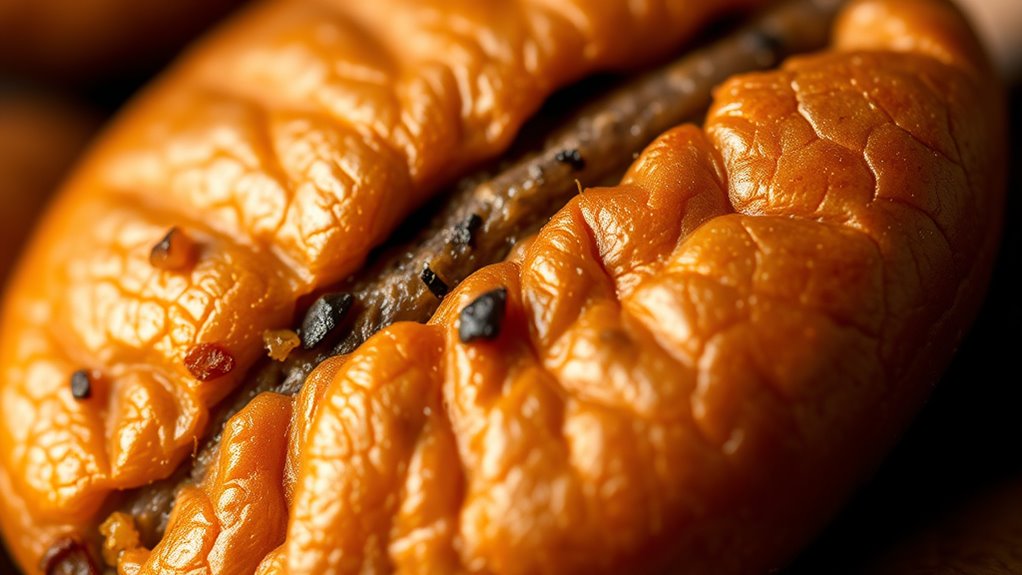
Several factors directly influence the Maillard reaction during roasting, shaping the development of flavor, aroma, and color in the final product. Your bean origin plays a role, as different regions contain varying sugar and amino acid levels, impacting reaction intensity. The roast level also matters; lighter roasts preserve more original flavors, while darker roasts intensify Maillard-driven characteristics. Temperature and time are critical—higher heat accelerates browning, but overdoing it can cause undesirable burnt notes. Moisture content affects the reaction too; drier beans favor Maillard browning. Additionally, the initial bean composition and pre-roast processing methods influence how effectively the Maillard reaction progresses. Understanding these factors helps you control the roast profile for *ideal* flavor development and consistent quality. Roast profile techniques enable roasters to optimize flavor outcomes by adjusting these variables precisely.
How the Maillard Reaction Affects Coffee and Food Profiles
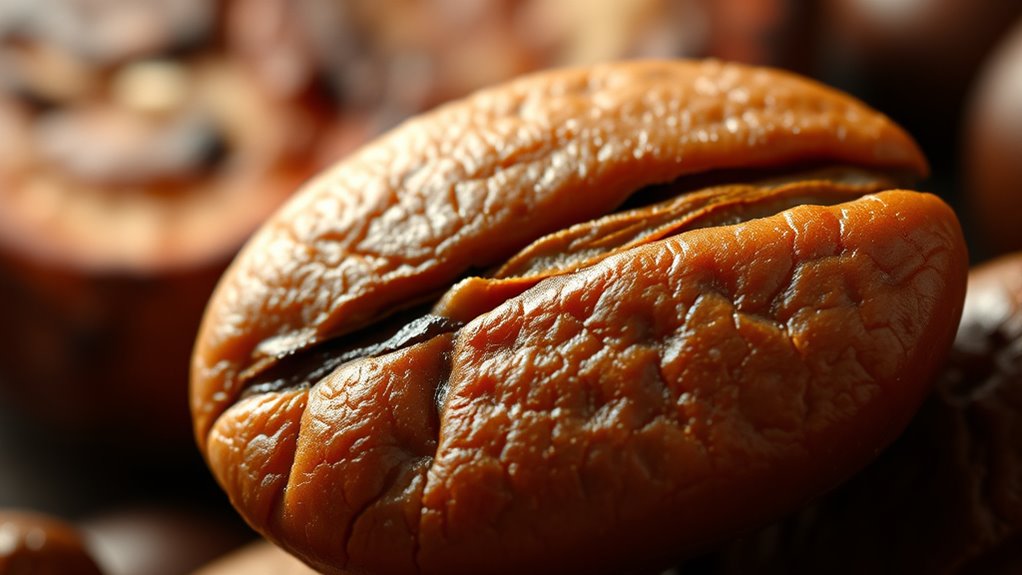
The Maillard reaction plays a crucial role in shaping the flavor, aroma, and color profiles of coffee and various foods. It creates intricate flavor complexity by forming new compounds that add depth and nuance to your cup or dish. As the reaction progresses, it enhances aromas, producing inviting, roasted, and caramelized scents that make your food more appealing. This process also influences color, giving coffee beans and cooked foods their rich, appetizing hues. Without the Maillard reaction, flavors would be simpler and aromas less vibrant. Instead, it introduces layers of taste and scent, making each sip or bite more engaging. Understanding this reaction helps you appreciate how roasting and cooking techniques develop the rich profiles you enjoy in coffee and food. The Maillard reaction significantly impacts the development of these sensory qualities, making it a fundamental aspect of culinary and coffee roasting processes.
Techniques to Control and Optimize the Maillard Reaction

Controlling and optimizing the Maillard reaction requires careful attention to factors like temperature, time, and moisture levels during roasting or cooking. To achieve consistent flavor balancing, you can use innovative techniques such as precise temperature control, adjusting airflow, or monitoring humidity. These methods help you influence the development of browning and aroma while preventing over- or under-reaction. Additionally, understanding celebrity lifestyle insights can inspire creative approaches to flavor and presentation. Consider these approaches:
- Using advanced temperature management systems for consistent heat application
- Modulating moisture levels to control reaction speed and flavor complexity
- Experimenting with different roasting profiles to fine-tune flavor development and color
Practical Tips for Roasters to Enhance Flavor Development
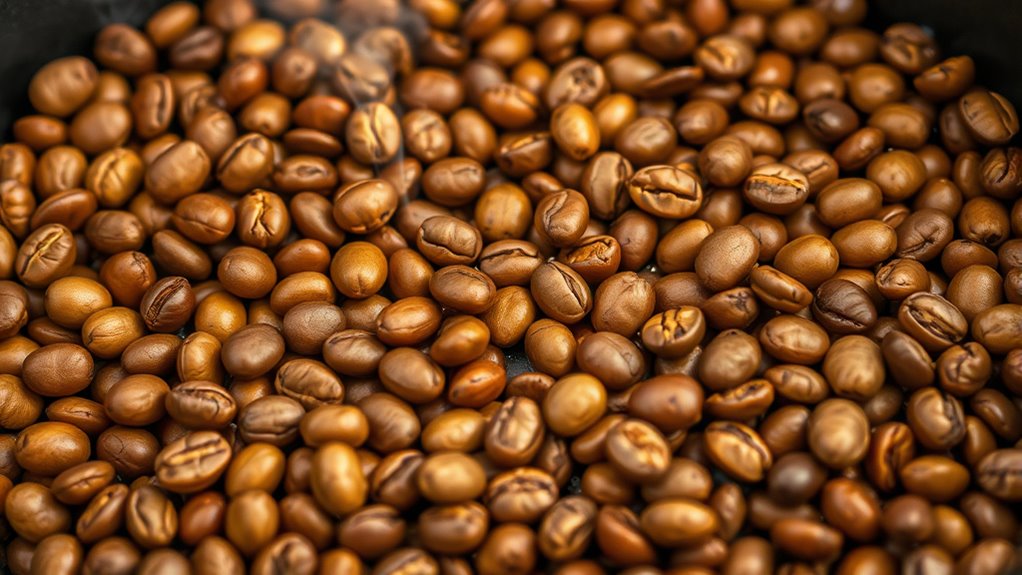
To enhance flavor development, you should carefully control your roast temperature and keep a close eye on timing. Using strategies like adjusting roast duration can help optimize the Maillard reaction without overdoing it. Additionally, consider incorporating Maillard promoters to boost browning and deepen flavor complexity.
Control Roast Temperature
Adjusting roast temperature precisely is essential for optimizing flavor development during the Maillard reaction. Effective temperature control allows you to influence caramelization and browning, shaping your roast profile. To do this:
- Monitor your temperature closely throughout the roast, making small adjustments as needed.
- Use consistent heat sources and roasting equipment to maintain stable temperatures.
- Track your roast profiling data to identify ideal temperature curves for desired flavor outcomes.
- Incorporating precise temperature control can significantly improve your ability to achieve consistent and desirable roast results.
Time Management Strategies
Effective time management is crucial for maximizing flavor development during the Maillard reaction. By controlling roast duration, you guarantee ideal process optimization, preventing under- or over-roasting. Prioritize consistent timing to develop complex flavors without sacrificing sweetness or creating burnt notes. Use the table below to plan your roasting stages precisely:
| Stage | Recommended Time | Key Focus |
|---|---|---|
| Drying Phase | 4-6 minutes | Remove moisture, uniform heat |
| Maillard Phase | 8-12 minutes | Promote browning, flavor depth |
| Caramelization | 2-4 minutes | Achieve sweetness, color |
| Cooling | Immediate | Halt reactions, stabilize |
Stick to these timings to enhance your process, ensuring each roast hits the perfect flavor profile. Additionally, understanding the Pimple Patch technology can help optimize your approach to managing surface reactions and impurities during roasting.
Use of Maillard Promoters
Utilizing Maillard promoters can considerably boost flavor development during roasting. These additives or techniques accelerate the Maillard reaction, leading to richer, more complex flavors. To maximize flavor enhancement, consider the following strategies:
- Adjust moisture levels by controlling humidity to optimize Maillard activity.
- Use specific ingredients like amino acids or sugars that act as natural Maillard promoters.
- Fine-tune temperature profiles to maintain ideal heat levels for promoting browning without over-roasting.
- Incorporate natural materials like wood or stone to influence heat transfer and promote desirable browning in certain roasting methods.
Implementing these Maillard promoters allows you to create more aromatic, flavorful roasts with depth and complexity. By carefully managing these factors, you can enhance the overall flavor profile of your coffee, ensuring a more satisfying experience for your customers. Remember, small adjustments can lead to significant flavor improvements.
Frequently Asked Questions
How Do Different Roasting Equipment Impact the Maillard Reaction?
Different roasting equipment substantially impacts the Maillard reaction through variations in the roasting chamber and heat distribution. You’ll find that a well-designed chamber guarantees even heat exposure, promoting consistent browning and flavor development. Equipment with precise heat distribution prevents hot spots, allowing the Maillard reaction to occur uniformly. This control helps you achieve desired roast profiles, enhancing aroma, taste, and color, ultimately giving you a better, more balanced roast every time.
Can the Maillard Reaction Be Reversed or Halted During Roasting?
Imagine trying to stop a wildfire in its tracks—you can’t really reverse it, but you can control it. The same goes for the Maillard reaction during roasting. Chemical inhibition through precise temperature control can halt or slow this process, preventing overdevelopment. While you can’t truly reverse the Maillard reaction once it begins, careful temperature management lets you influence its progression, ensuring your roast hits the perfect flavor profile without crossing into bitterness.
What Role Does Moisture Content Play in Maillard Browning?
Moisture levels markedly influence browning control during roasting. When moisture content is high, it slows down the Maillard reaction, preventing excessive browning and ensuring even roasting. As moisture decreases, browning accelerates, creating richer flavors and color. You should monitor moisture carefully to balance browning control, avoiding underdeveloped or overdone roasts. Adjusting airflow and temperature helps manage moisture levels, giving you better control over the Maillard process.
Are There Health Implications Linked to Maillard Reaction Products?
Think of Maillard reaction products as flavorful sparks flying from your cooking. While they create delicious aromas and colors, health concerns and dietary effects arise because some compounds may form carcinogens or contribute to inflammation. Moderation is key, as excessive intake might impact your health over time. Being mindful of your cooking methods helps balance enjoying tasty foods with minimizing potential risks from these reaction products.
How Does Altitude Influence the Maillard Process in Roasting?
Altitude effects influence your roasting process because higher elevations lower the boiling point of water, requiring you to adjust roasting temperature. At higher altitudes, you need to increase the temperature to achieve the same Maillard reaction as at sea level. This means you’ll roast beans slightly longer or at higher heat to develop the desired flavor profile, ensuring the Maillard process occurs effectively despite the altitude’s impact on roasting conditions.
Conclusion
By understanding the Maillard reaction, you hold the key to revealing rich, intricate flavors in your roasting journey. Think of it as conducting a symphony, where each gentle nudge shapes the aroma and taste that dance on your palate. Mastering this delicate chemistry allows you to paint your coffee’s profile with bold strokes and subtle hues, transforming simple beans into a masterpiece that sings with depth and character.
